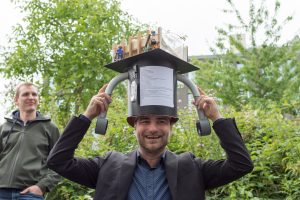Am 10. Juli 2020 hat Herr Lukas Aspöck seine mündliche Promotionsprüfung erfolgreich abgeschlossen.
Herr Aspöck promovierte über das Thema:
„Validation of room acoustic simulation models“
Abstract:
Already in ancient times, the goal existed to design appropriate environments to transport acoustic signals from a sound source to an audience. Strongly connected to this is the interest to understand room acoustic effects and, in the best case, to accurately predict them. This is of particular relevance today in prestigious projects such as the construction of concert halls, but is also of great importance in everyday life, for example in public buildings. Room acoustic simulations based on the concepts of geometric acoustics have been developed for such purposes for more than 50 years and have been extensively investigated. However, there is still insufficient knowledge about the uncertainty and validity of the results of the room acoustic simulations used today. In addition, many highly simplified simulation models are often used without questioning the validity of the results.
In order to offer developers and researchers a possibility to comprehensively validate the results of their room acoustic simulation, a database with eleven different acoustic scenes was developed, documented and published. The scenes cover both simple environments, where individual acoustic effects such as reflection or diffraction are isolated, and complex spatial situations such as a concert hall. In addition to a detailed description and the definition of input data, acoustic measurements were carried out for all scenes, which serve as reference for the simulations.
Furthermore, a study is presented which was designed following the concept of three previously conducted round robin experiments. Here, the simulation results of up to six participants, who were not informed about measurement results in advance, are compared with each other and with the results of the corresponding measurements. The evaluation of the results for the simple scenes reveals various weaknesses of the geometric acoustics, but in the case of the complex scenes it nonetheless shows acceptable results in the medium frequency range. In further investigations it was determined how much room acoustic simulation results deviate from measurements if the user knows the measurement results beforehand and input data of the simulation is adjusted manually or systematically. From these results it can be concluded which deviations from actual, measured values can be expected in the room acoustic simulation of both unknown and known rooms. Furthermore, this work provides a basis for improvements in the field of geometrical acoustics simulation models and with respect to the determination and selection of correct input data for the simulation.
Das ITA gratuliert sehr herzlich!!


